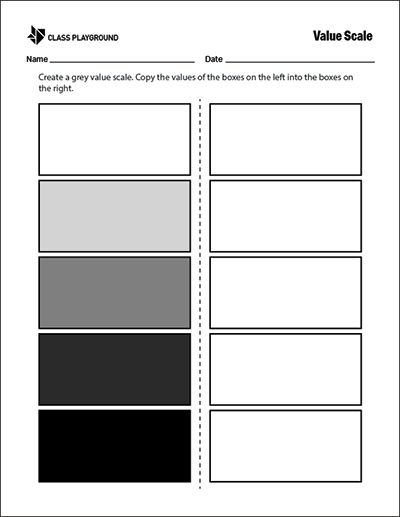What is Value?
Value refers to the relative lightness or darkness of colors and tones in an artwork. It is a crucial element that adds depth, form, and visual interest to artistic compositions. By manipulating the intensity of light and shadows, artists can create a sense of three-dimensionality and evoke specific moods or atmospheres in their artwork.
Why Teach Value?
Teaching value to elementary students is essential as it helps them develop important visual perception skills and enhances their artistic understanding. By comprehending value, students can effectively communicate emotions, create more realistic and engaging artwork, and gain a deeper appreciation for the artistic process.
Strategies
- Gradual Value Scale: Begin by introducing students to a gradual value scale. This visual tool demonstrates the transition from the lightest value (white) to the darkest value (black). Encourage students to create their own value scales using shades of gray, gradually transitioning from light to dark. This activity helps them understand the concept of value and how it affects the overall appearance of an artwork.
- Value in Nature: Take students on a nature walk or bring natural objects into the classroom. Encourage them to closely observe various objects such as leaves, flowers, or rocks, paying attention to the different values present. Discuss how light affects these objects, creating areas of highlight and shadow. Students can then create artworks using different values to depict the observed objects, capturing the interplay of light and shadow.
- Still-Life Drawings: Set up a still-life arrangement using common objects with varying shapes and surfaces. Guide students in observing the values present in the objects and demonstrate shading techniques such as hatching, cross-hatching, and blending. Encourage students to carefully analyze the way light falls on the objects and recreate the range of values in their drawings. This activity allows students to practice capturing the three-dimensionality of objects and understanding how value affects form.
- Value Collages: Provide students with a variety of materials, including colored paper, magazines, fabric, and glue. Instruct them to cut out shapes or images of different values and arrange them on a contrasting background. Encourage students to explore the visual impact created by contrasting light and dark values. This hands-on activity helps students understand how value can be used to create dynamic compositions and evoke specific emotions.
Activities
- Value Self-Portraits: Have students create self-portraits using varying values to depict the form and features of their faces. Encourage them to use lighter values for areas that receive more direct light and darker values for areas in shadow. This activity allows students to explore the complexity of capturing value in portraiture and express their individuality through artwork.
- Value in Famous Artwork: Introduce students to famous artworks that effectively utilize value, such as Rembrandt’s “Self-Portrait as the Apostle Paul” or Vermeer’s “Girl with a Pearl Earring”. Analyze how these artists skillfully use light and dark values to create depth, drama, and emotion. Then, ask students to create their own artwork inspired by these masterpieces, incorporating value as a central element.
- Collaborative Murals: Divide the class into small groups and assign each group a large piece of paper or canvas. Instruct them to collaborate on a mural that emphasizes the use of value. Encourage students to work together to create a composition with contrasting values, creating visual interest and depth. This activity promotes teamwork, creativity, and the exploration of value in a larger-scale artwork.

